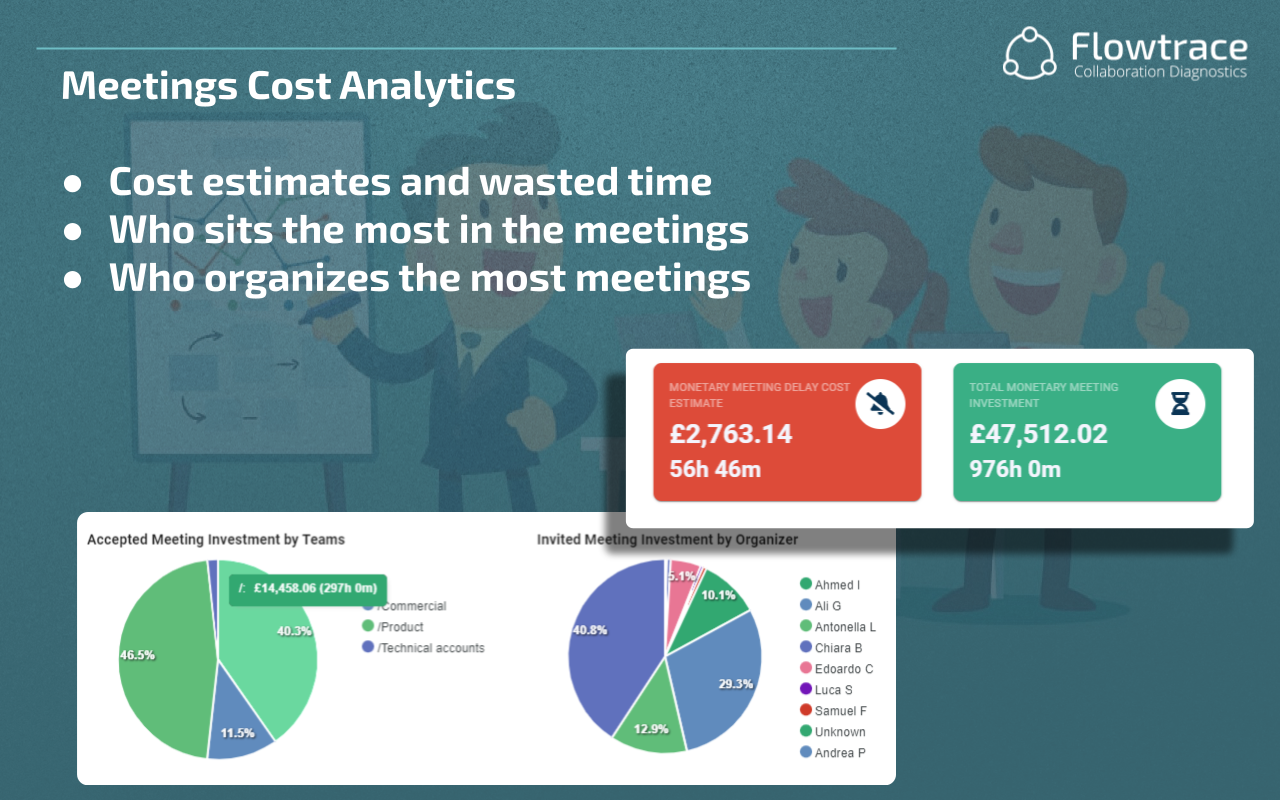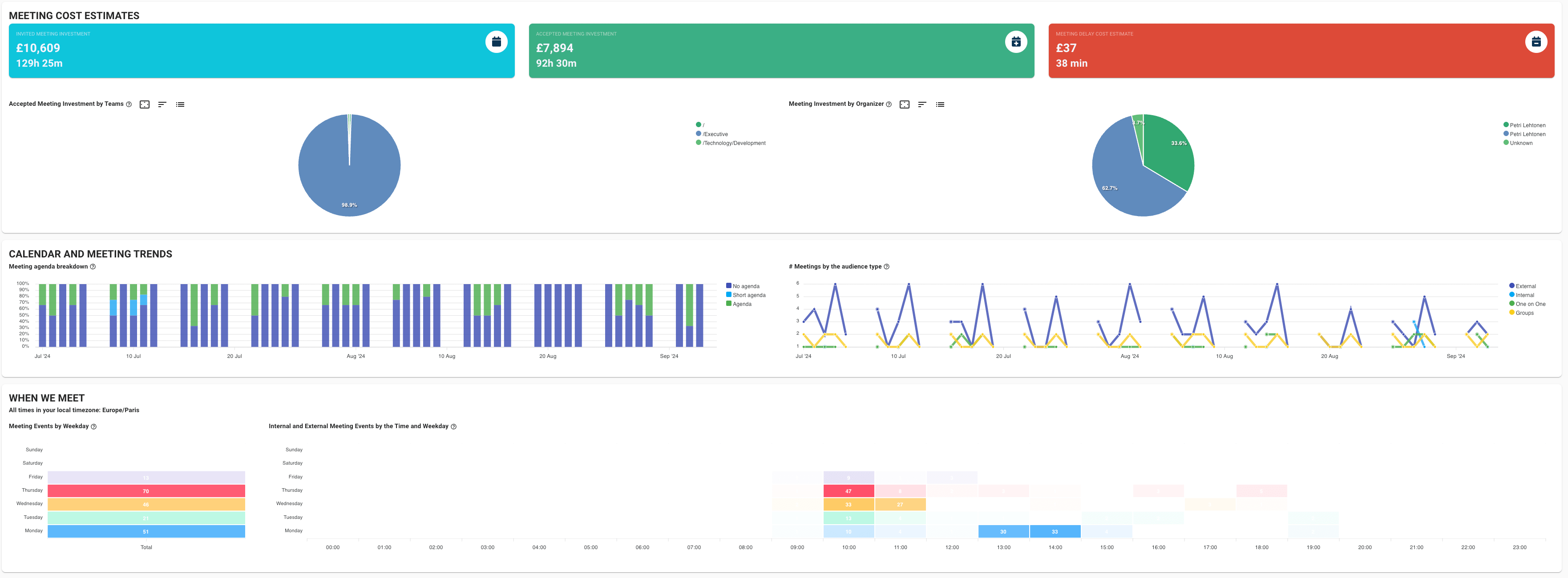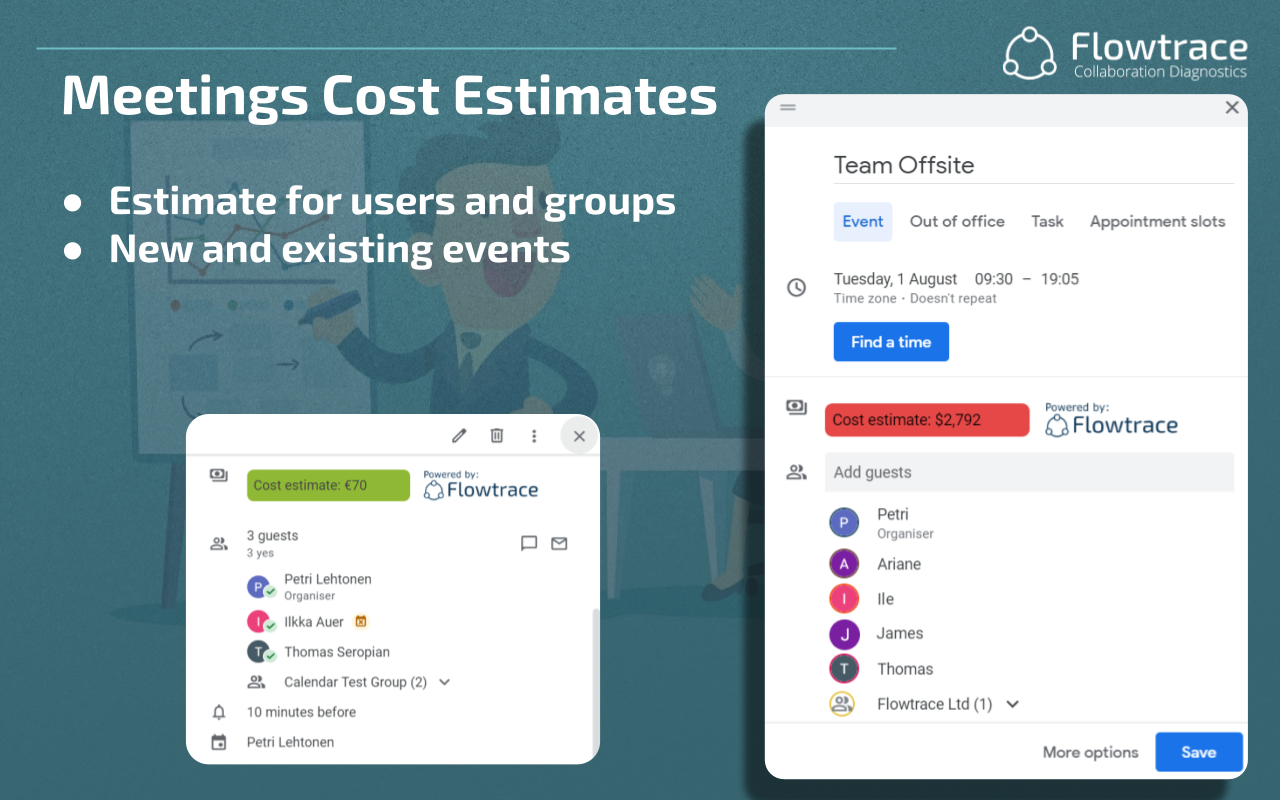How to Make Data-Driven Meeting Improvements
Optimize your meetings with a data-driven approach. Learn how to analyze key metrics to improve efficiency, reduce costs, and enhance collaboration.
Discover the hidden costs of meetings and learn strategies to manage them effectively for increased productivity and reduced expenses.
Do meetings really cost money? The answer is a resounding yes. Each minute spent in a meeting represents a tangible cost, from employee salaries tied to time spent discussing agenda items to the operational overhead incurred for meeting rooms, technology, and coordination. Beyond the direct expenses, there are hidden costs, such as decreased productivity, disruption of focused work, and diminished morale when meetings become redundant or poorly structured.
"It has long puzzled me why calling a $10'000 meeting is easier than expensing $50 client lunch." - Petri Lehtonen
This article will look at the financial, productivity, and resource implications of meetings and why they need careful management supported by analytics.
Meetings are essential for collaboration and decision-making in organizations, but they come with both direct and indirect costs that can impact a company's bottom line.
Direct costs are the immediate, tangible expenses associated with organizing and conducting meetings. These include:
Beyond the obvious expenses, there are also indirect cost of meetings that are less apparent but equally impactful:


Understanding both the direct and hidden costs of meetings is crucial for organizations aiming to optimize their operations and allocate resources effectively. By recognizing these expenses, companies can implement strategies to conduct more efficient meetings, thereby reducing unnecessary costs and enhancing productivity.
Meetings cost money because they consume valuable resources, including employee time, salaries, and operational overhead. When participants gather, their collective hourly wages translate into direct expenses, while meeting preparation, follow-ups, and interruptions to focused work compound these costs. Understanding these financial implications is key to optimizing how meetings are scheduled and conducted.

Time is a finite and valuable resource in any organization. When employees spend time in meetings, especially those that are unproductive or unnecessary, it translates directly into financial costs. For instance, a study by Doodle found that unnecessary meetings cost U.S. businesses $399 billion in 2019.
Meetings contribute to overhead costs in several ways:
These overhead expenses accumulate over time, impacting the organization's operational budget.
Inefficient meetings can have cascading effects on productivity:
Recognizing these factors is essential for organizations aiming to optimize their meeting practices, reduce unnecessary costs, and enhance productivity.
Meetings often come with hidden yet substantial costs that can significantly impact an organization's financial health. To fully grasp their weight, it is helpful to contextualize these costs alongside other common business expenses and to explore their long-term impact on performance.
When analyzing business expenditures, meeting costs are often overlooked in favor of more visible budget lines, such as marketing campaigns, employee training programs, or infrastructure investments. However, meetings can be a comparable, if not greater, financial drain. For example, while marketing budgets are typically tied to measurable returns on investment (ROI), meeting costs often lack such direct accountability, resulting in unchecked resource consumption.
Similarly, training programs are generally designed to upskill employees, providing long-term organizational value, whereas poorly structured meetings may offer limited or no tangible return.
Unlike traditional expenses, meetings involve multiple hidden layers of costs, including lost productivity and disruption of work routines. Comparing the cumulative expense of frequent meetings across departments can reveal their significant burden, often outweighing other direct business costs when scaled over time.
The long-term implications of poorly managed or excessive meetings extend beyond financial considerations. When meetings are unproductive, they create ripple effects that can weaken overall organizational efficiency. For example, repeated gatherings without clear outcomes can lead to inefficiencies, as employees spend valuable time revisiting unresolved issues or navigating unclear objectives. Over time, this cycle erodes both individual productivity and collective progress.
Furthermore, an overabundance of unstructured meetings can result in diminished employee engagement and satisfaction. As teams become accustomed to meeting fatigue, their ability to innovate, collaborate effectively, and focus on strategic priorities suffers. This can weaken a company's competitive edge, making it slower to adapt to market changes and less responsive to customer needs.
Effectively managing meeting expenses begins with understanding how to quantify their costs. By employing straightforward methods and formulas, organizations can gain a clearer picture of the financial investment involved and identify opportunities for optimization.
.png?width=1366&height=768&name=Outlook%20Add%20In%20Store%20Images%20-%201%20(1).png)
Calculating meeting costs involves a few key variables:
These are some examples of how meetings can add up in costs. You can also use our meeting cost calculator to work out the costs for your organization.
Consider a weekly departmental check-in with 15 employees, each earning an average of $60 per hour. A one-hour meeting costs $900 in direct labor costs. Over a year, this single meeting amounts to $46,800 in employee time. If the meeting is deemed unproductive or redundant, this expense represents a considerable drain on resources.
A biweekly project review session involving 20 participants costs $1,200 per hour based on an average hourly rate of $60. Across 26 meetings per year, the total cost is $31,200. This calculation excludes indirect costs such as productivity losses and preparation time, which could further amplify the true cost.
You can also check out meeting costs for Google Calendar and meeting costs for Outlook to automatically calculate your meeting costs in real-time.
Reducing meeting costs requires a proactive approach to planning, structuring, and evaluating every aspect of meetings. By implementing key strategies, organizations can ensure that meetings are valuable, focused, and efficient.
A well-defined agenda is essential for maintaining focus and reducing wasted time. When meetings have a clear agenda outlining discussion points, goals, and outcomes, participants can come prepared, minimizing off-topic conversations and ensuring efficient use of time.

A clear agenda serves as a roadmap for discussions, preventing meetings from veering off course and keeping participants engaged. Adhering to this structure allows meetings to conclude on time and with tangible results, reducing costs associated with extended or unfocused discussions.
Inviting only essential participants is another effective way to reduce meeting costs. Each additional attendee represents an investment of time and resources, so ensuring that only those who are directly involved or have a critical role are present can make meetings leaner and more productive.

Smaller meetings tend to foster more meaningful conversations, as participants can contribute without being overshadowed by larger group dynamics. By limiting attendees to those who are essential, organizations reduce the total cost of meetings while maintaining relevance and focus.
Utilizing meeting analytics is a powerful way to understand and minimize meeting-related expenses. By analyzing metrics such as meeting frequency, duration, cost per attendee, and engagement levels, organizations can identify unproductive or redundant meetings that drain resources.

Detailed data allows for precise adjustments, such as reducing the number of participants, shortening meeting times, or shifting to asynchronous updates where possible. This data-driven approach ensures that meetings provide value without unnecessary costs, empowering businesses to allocate resources more effectively and maximize return on investment.
Regularly reviewing meeting frequency and necessity ensures that only productive and essential meetings remain on the calendar. Conduct periodic evaluations of recurring meetings, assessing whether they still serve their intended purpose and contribute value.
Meetings that consistently lack outcomes, duplicate previous discussions, or no longer align with organizational priorities can be modified, consolidated, or eliminated. This approach prevents meetings from becoming routine, ensuring that every gathering serves a strategic purpose and justifies its cost.
Adopting a data-driven approach to meeting management can significantly improve efficiency and reduce costs. By tracking and analyzing key metrics, organizations gain the insights needed to optimize their meeting practices, ensuring that each session delivers meaningful outcomes without wasting time or resources.
The first step in rethinking meeting practices is consistent tracking and monitoring of meeting trends, durations, and costs. Gathering data on how frequently meetings are held, their average duration, and how much they cost, provides a comprehensive view of meeting culture within an organization. Real-time dashboards and analytics tools can help visualize these metrics, making it easier to identify inefficiencies, such as consistently overlong meetings or recurring sessions that lack purpose.
Tracking engagement metrics, attendance patterns, and follow-up completion rates can also offer valuable insights into meeting effectiveness. For example, if data reveals that a significant portion of attendees routinely skip a specific recurring meeting, it may indicate that the session lacks relevance or could be consolidated.
Data insights provide a solid foundation for refining the frequency and length of meetings. When metrics show that certain types of meetings consistently exceed their scheduled durations, organizations can explore strategies to streamline discussions or break meetings into shorter, focused sessions. Similarly, if recurring meetings show diminishing returns, reducing their frequency may allow for more focused, impactful discussions when they do occur.

Adjusting meeting cadences based on data helps prevent meeting fatigue and ensures that employees have ample time for uninterrupted, deep work. Organizations can experiment with different formats, such as shorter stand-up meetings or focused brainstorming sessions, and use data to evaluate their effectiveness.
Flowtrace offers organizations powerful tools to analyze and optimize their meeting practices by providing real-time insights into key metrics, such as meeting costs, participation, and overall effectiveness. With this data-driven approach, Flowtrace empowers businesses to transform meetings from a potential drain on resources into productive, value-driven interactions.
Flowtrace tracks and visualizes the financial cost of meetings based on participant salaries and meeting durations, making it easy for leaders to assess the return on investment for each gathering. Detailed cost breakdowns allow organizations to pinpoint high-expense meetings and evaluate whether they are delivering proportional value.

Additionally, Flowtrace provides insights into participation metrics, including attendance rates, frequency, and punctuality trends. This data reveals whether meetings are engaging the right people and if certain sessions are being overstaffed or underutilized.
Flowtrace’s data-driven platform allows organizations to identify inefficiencies and make informed adjustments to their meeting culture. For example:
Meetings, while necessary, can often lead to significant financial and productivity losses if not managed effectively. Poorly structured or excessive meetings can waste resources, disrupt workflows, and lower employee morale. To drive meaningful change, organizations must adopt data-driven approaches to streamline meetings, reducing costs and maximizing value. Flowtrace offers the tools to understand meeting practices and costs, helping businesses enhance productivity, build collaboration, and create a better meeting culture.
Optimize your meetings with a data-driven approach. Learn how to analyze key metrics to improve efficiency, reduce costs, and enhance collaboration.
Optimize meeting effectiveness with data-driven metrics on preparation, cost, participation, timing, and accountability to enhance productivity and...
Optimize meetings to save costs and boost productivity with these 8 strategies, including agendas, right participants, punctuality, and analytics.